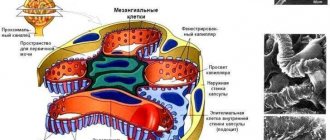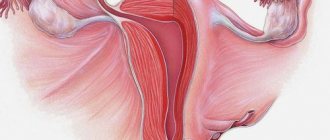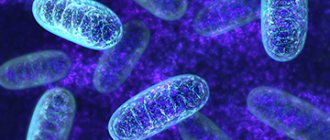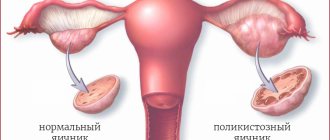Adrenogenital syndrome.
Adrenogenital syndrome (AGS) is a hereditary pathology associated with insufficient production of enzymes by the adrenal cortex, accompanied by an excess of sex hormones and a lack of glucocorticoids. Adrenogenital syndrome has another name - adrenal hyperandrogenism.
The classic form of congenital adrenogenital syndrome.
Hyperproduction of androgens begins in utero with the onset of hormonal function of the adrenal glands - the 9-10th week of intrauterine life. Under the influence of excess androgens, the sexual differentiation of the fetus of the female chromosomal sex is disrupted. During this period of intrauterine life, the gonads already have a clear gender identity, the internal genital organs also have a structure characteristic of the female sex, and the external genitalia are in the stage of formation.
From the so-called neutral type, the female phenotype is formed. Under the influence of excess testosterone, virilization of the external genitalia of the female fetus occurs: the genital tubercle enlarges, turning into a penis-shaped clitoris, labiosacral folds merge, taking on the appearance of a scrotum, the urogenital sinus is not divided into the urethra and vagina, but persists and opens under the penis-shaped clitoris.
This virilization leads to incorrect sex determination at birth. Since the gonads have a female structure (ovaries), this pathology received another name - false female hermaphroditism. Overproduction of androgens in the prenatal period causes adrenal hyperplasia; this form of adrenogenital syndrome is called the classic form of congenital adrenal hyperplasia.
Such children are patients of pediatric endocrinologists; tactics for their management and treatment have been developed, which allows for timely surgical gender correction and directing further development according to the female type.
The contingent of people turning to gynecologists-endocrinologists are patients with late forms of adrenogenital syndrome.
What causes adrenogenital syndrome?
The 21-hydroxylase enzyme gene is located on the short arm of chromosome 6. There are two genes - the active CYP21-B gene, encoding 21-hydroxylase, and the inactive CYP21-A pseudogene. These genes are largely homologous. The presence of a homologous DNA sequence near the coding gene often leads to pairing disorders in meiosis and, as a consequence, to gene conversion (movement of an active gene fragment to a pseudogene), or to deletion of part of the sense gene. In both cases, the function of the active gene is impaired. On chromosome 6, next to the CYP21 genes, there are HLA genes, which are inherited codominantly, as a result of which all homozygous sibs will have an identical HLA haplotype
Pathogenesis during adrenogenital syndrome.
If adrenogenital syndrome is detected, then the pathogenetic essence is the inhibition of the production of some corticosteroids while simultaneously increasing the production of others due to a deficiency of one or another enzyme that provides one of the stages of steroidogenesis. As a result of P450c21 deficiency, the process of transition of 17-hydroxyprogesterone to 11-deoxycortisol and progesterone to deoxycorticosterone is disrupted.
Thus, depending on the severity of the enzyme deficiency, a deficiency of cortisol and aldosterone develops. Cortisol deficiency stimulates the production of ACTH, the effect of which on the adrenal cortex leads to its hyperplasia and stimulation of the synthesis of corticosteroids, steroidogenesis shifts towards the synthesis of excess androgens. Hyperandrogenism of adrenal origin develops.
The clinical phenotype is determined by the degree of activity of the mutated CYP21-B gene. With its complete loss, a salt-wasting version of the syndrome develops, in which the synthesis of glucocorticoids and mineralocorticoids is disrupted. When moderate enzyme activity is maintained, mineralocorticoid deficiency does not develop due to the fact that the physiological need for aldosterone is approximately 200 times lower than for cortisol.
There are 3 variants of 21-hydroxylase deficiency:
- 21-hydroxylase deficiency with salt wasting syndrome;
- Simple viril form (incomplete 21-hydroxylase deficiency);
- Non-classical form (post-pubertal).
The prevalence of adrenogenital syndrome varies significantly among different nationalities. Among representatives of the European race, the prevalence of classical variants (salt waste and simple) of 21-hydroxylase deficiency is approximately 1 in 14,000 newborns. This figure is significantly higher among Jews (non-classical form of 21-hydroxylase deficiency - up to 19% of Ashkenazi Jews). Among Alaskan Eskimos, the prevalence of classic forms of 21-hydroxylase deficiency is 1 in 282 births.
Signs and symptoms
Manifestations depend on the nature of gene damage and the severity of enzyme deficiency, while determining the sex of a newborn is not always possible without genetic testing.
Symptoms will vary depending on the type of congenital adrenal hyperplasia and when the disorder was diagnosed.
• Children with the non-classical (post-pubertal, favorable) form may not have signs of congenital adrenal hyperplasia, and the diagnosis is made only in adolescence.
• Girls with more severe forms (salter and simple virile) often have abnormal genitals already at birth (female pseudohermaphroditism), which allows the pathology to be suspected before symptoms appear. Anomalies of genital development include complete or partial fusion of the labia, clitoromegaly (enlargement of the clitoris), formation of the urogenital sinus, and deepened vestibule of the vagina.
• Male newborns may not have any visual abnormalities, even if the disorder is severe.
In children with severe 21-hydroxylase deficiency in the salt-wasting form, symptoms develop within 2 or 3 weeks after birth; this variant of congenital adrenogenital syndrome in both boys and girls is characterized by:
• refusal to eat, vomiting, diarrhea; • inability to grow and develop; • dehydration; • hypotension (low blood pressure); • electrolyte imbalance: abnormal levels of sodium (hyponatremia) and potassium (hyperkalemia) in the blood, seizures; • excessive skin pigmentation; • abnormal heart rhythm.
If the pathology is not diagnosed in a timely manner and hormonal therapy is not started, a life-threatening adrenal crisis may develop.
Often, the condition of boys is mistaken for the consequences of pyloric stenosis and gastroenteritis, which leads to death due to lack of glucocorticoids.
Girls with postpubertal (a milder form compared to salt-wasting and simple virile) retain normal female genital organs (vagina, ovaries, uterus and fallopian tubes).
As you get older, the following appear:
• menstrual irregularities such as oligomenorrhea, late arrival of menarche (first menstruation); • underdevelopment of the mammary glands; • early appearance of hair growth in the pubic and axillary areas; • excessive hair growth on the body and face; acne and hypersecretion of the sebaceous glands; • enlargement of the clitoris.
With simple virile adrenogenital syndrome, menstruation, despite all the signs of early (up to 7 years) puberty, is absent, underdevelopment of the mammary glands, body imbalances, and short stature. Pronounced virilization: enlargement of the clitoris, formation of the Adam's apple, rough voice, etc.
In boys entering puberty, symptoms include:
• low voice timbre; • large penis with normal-sized testicles; • pronounced secondary sexual characteristics; • increased hyperpigmentation of the scrotum; • good muscle development.
Testicular biopsy in men reveals immature tubules and absence of Leydig cells, which can result in infertility.
In childhood, girls and boys are taller than their peers, but the height of adults with adrenogenital syndrome is significantly lower than that of healthy people. The exception is the postpubertal form, in which signs of adrenal insufficiency appear later. Changes in body proportions include a narrow pelvis, broad shoulders, shortened limbs, and developed muscles.
Causes of adrenogenital syndrome.
There are 2 main causes of adrenogenital syndrome:
- Hereditary defect of 21-hydroxylase;
- Acquired tumor of the adrenal glands that synthesizes excess hormones.
Adrenogenital syndrome and its symptoms are inherited in most cases. The type of inheritance of the disease is autosomal recessive. This means that if one of the parents is a carrier of a pathological gene, and the other is healthy, in 50% of cases they will have a healthy child, and in 50% - a carrier. Such parents cannot have a sick baby.
If both parents are carriers of the pathological gene, then with a probability of 25% they will have a healthy baby, 25% - a sick one, and 50% - a carrier of the gene. When planning a family, family members of the patient should consult a medical geneticist about the risk of the disease in their offspring.
Congenital adrenal hyperplasia can also occur in boys, but most often affects girls. They have a genetic defect responsible for the deficiency of the enzyme 21-hydroxylase. This substance is responsible for the production of the hormones cortisol and aldosterone, and in its absence the production of male hormones - androgens - is activated. Therefore, signs of virilization or hermaphroditism appear.
Sometimes there is a deficiency of other adrenal cortex enzymes.
Pathogenesis
If we talk about the fact that this is VDCN, then we can say that this condition is directly related to a decrease in the level of cortisol in the blood serum under the influence of the above-mentioned enzymes. Against the background of a decrease in serum cortisol, an increase in the secretion of adrenogenital hormones is observed, provoking hyperplastic changes in the adrenal cortex. The result of this process is increased production of androgens. Against the background of complex biochemical processes that form during adrenogenital syndrome, a cascade of sequential reactions is observed:
- Insufficient production of cortisol.
- Compensatory increase in adrenocorticotropic hormone levels.
- Decreased aldosterone levels in the body.
- Increasing the concentration of biologically active substances such as androgens, 17-hydroxyprogesterone and progesterone.
Symptoms of adrenogenital syndrome.
Adrenogenital syndrome cannot be called a deadly pathology, but some symptoms can cause a person many unpleasant moments or even lead to a nervous breakdown. If adrenogenital syndrome is detected in a newborn, parents have time to help the child with social adaptation. But if a student is diagnosed, the situation often gets out of control, which in some cases can lead to the most unpredictable consequences.
The clinical manifestations themselves are as follows:
- persistent increase in blood pressure (BP);
- skin pigmentation;
- short stature that does not correspond to the child’s age;
- effects from the gastrointestinal tract: diarrhea, vomiting, excessive gas formation;
- periodic convulsions.
In addition, “boys” are characterized by a disproportionately large penis, and patients with the non-classical form of AGS often complain of problems with conception and pregnancy, which is why they have practically no chance of becoming mothers (in the absence of adequate treatment).
How to identify adrenogenital syndrome in children
Diagnosis of the disorder is based on phenotypic and anamnestic data. During a general examination, the degree of hair growth and the condition of the genital organs are assessed. Late or incorrect diagnosis of congenital forms of adrenogenital disorders can lead to the death of a child in the first days of life. Carrying out neonatal screening makes it possible to timely prescribe adequate hormone replacement therapy and correctly determine the gender of an infant with the syndrome.
The pathogenetic marker of the disorder is the determination of 17-hydroxyprogesterone in a blood sample taken on a Guthrie card. Values exceeding 400 ng/100 ml have diagnostic value. Prenatal screening for adrenogenital syndrome is carried out by determining the content of 17-hydroxyprogesterone in the amniotic fluid. The ability to use molecular genetic analysis is limited due to the fact that there are more than 10 mutations that block the synthesis of 21-hydroxylase. The following instrumental diagnostic methods are used:
- radiography of the wrist joints – determines existing deformities and establishes the so-called “bone” age of patients with adrenogenital disorders;
- Ultrasound of the pelvic organs – reveals pathologies of the uterus and ovaries;
- tomographic examination of the adrenal glands - used to identify tumor processes.
Diagnosis of adrenogenital syndrome.
To establish a diagnosis, it is necessary to undergo an examination by an obstetrician-gynecologist, dermatovenerologist, urologist-andrologist, geneticist, ophthalmologist, endocrinologist and pediatric cardiologist.
An important factor in diagnosis is taking tests that will help determine the level of chlorides, sodium, and potassium in the blood. You should donate blood for hormones, urine for general analysis, biochemical, and clinical blood tests.
Girls undergo an ultrasound examination of the appendages and uterus, boys - an ultrasound examination of the scrotum. In addition, an ultrasound examination of the retroperitoneal organs should be done. For diagnostic effectiveness, it is necessary to conduct a magnetic resonance imaging of the brain and an electrocardiogram.
Adrenogenital syndrome is differentiated from hermaphroditism, adrenal insufficiency and androgen-producing adrenal tumor, and the salt-wasting form is differentiated from pyloric stenosis (impaired gastric emptying).
Treatment of adrenogenital syndrome.
Glucocorticoid drugs are used to correct the hormonal function of the adrenal glands.
Currently, dexamethasone is prescribed at a dose of 0.5-0.25 mg. per day under the control of blood androgens and their metabolites in the urine. The effectiveness of therapy is evidenced by the normalization of the menstrual cycle, the appearance of ovulatory cycles, which is recorded by measuring basal temperature, echoscopy data of the endometrium and ovaries in the middle of the cycle, and the onset of pregnancy. In the latter case, glucocorticoid therapy is continued to avoid termination of pregnancy until the 13th week - the period of formation of the placenta, which provides the necessary level of hormones for the normal development of the fetus.
During the first weeks of pregnancy, careful monitoring is necessary: up to 9 weeks - measurement of basal temperature, once every two weeks - ultrasound to detect increased myometrial tone and echoscopic signs of detachment of the ovum. In case of a history of spontaneous miscarriages, estrogen-containing drugs are prescribed to improve the blood supply to the developing embryo: microfollin (ethinyl estradiol) 0.25-0.5 mg per day or progynova 1-2 mg per day under monitoring the woman’s condition and whether she has complaints of lower pain abdomen, bloody discharge from the genital tract.
Currently, in the treatment of miscarriage with adrenogenital syndrome in the 1st-2nd trimester of pregnancy, the use of an analogue of natural progesterone - duphaston 20-40-60 mg per day is effective. Being a derivative of dydrogesterone, it does not have an androgenic effect, unlike norsteroid progestogens, which is manifested by signs of virilization in the mother and masculinization in the female fetus. In addition, the use of duphaston is effective in the treatment of functional isthmic-cervical insufficiency, which often accompanies adrenogenital syndrome.
In the absence of pregnancy (ovulation or insufficiency of the corpus luteum, recorded according to basal temperature data), it is recommended, against the background of glucocorticoid therapy, to stimulate ovulation with clomiphene according to the generally accepted scheme: from the 5th to the 9th or from the 3rd to the 7th day of the cycle according to 50-100 mg.
In cases where a woman is not interested in pregnancy, and the main complaint is excessive hair growth, pustular rashes on the skin or irregular menstruation, therapy with drugs containing estrogens and antiandrogens is recommended (see Treatment of hirsutism in PCOS). The drug Diane-35 is most often prescribed. It is more effective in relation to hirsutism against the background of Diane to prescribe cyproterone acetate at a dose of 25-50 mg (the drug Androkur) for the first time for 10-12 days. The use of these drugs for 3-6 months gives a pronounced effect.
Unfortunately, after taking the drugs, the symptoms of hyperandrogenism reappear, since this therapy does not eliminate the cause of the pathology. It should also be noted that the use of glucocorticoids, which normalize ovarian function, has little effect on reducing hirsutism. Oral contraceptives that contain the latest generation of progestins (desogestrel, gestodene, norgestimate) have an antiandrogenic effect. Among non-hormonal drugs, veroshpiron is effective, which at a dose of 100 mg per day for 6 months or more reduces hirsutism.
With a late postpubertal form of adrenogenital syndrome, with mild skin manifestations of hyperandrogenism and an unstable menstrual cycle without long delays, patients, if they are not interested in pregnancy, do not need hormonal therapy.
When using hormonal contraceptives, preference is given to low-dose monophasic (Mersilon) and triphasic with a gestagen component of the latest generation (desogestrel, gestodene, norgestimate), which do not have an androgenic effect. Long-term use of single-phase hormonal contraceptives containing 30 mcg of ethinyl estradiol such as Marvelon or Femoden (more than a year without a break) can cause hyperinhibition of ovarian function and amenorrhea due to hypogonadotropic disorders, rather than hyperandrogenism.
Classification
For ease of diagnosis, in medical practice adrenogenital syndrome is conventionally classified into several main forms, among which are:
- Salt form. This type of disease is the most common. Most often, salt-wasting adrenogenital syndrome is diagnosed in the neonatal period, as well as in children under the age of 1 year. This condition is characterized by hormonal imbalance and functional insufficiency of the adrenal cortex. At the time of examination of such children, a decrease in aldosterone to minimal levels is detected. The hormone aldosterone ensures the balance of water and electrolytes in the human body, so its lack leads to functional disorders of the cardiovascular system, as well as instability of blood pressure.
- Viril form. This condition belongs to the classic variants of the course of adrenogenital syndrome. In this situation, adrenal insufficiency is not observed. The changes affect only the area of the external genitalia. Clinical manifestations of the virile form of adrenogenital syndrome make themselves felt from the very moment of birth. There are no other changes in organs and systems.
- Postpubertal form. This form of adrenogenital syndrome belongs to the non-classical form of CAI, and, as a rule, is diagnosed more often in women with increased sexual activity. The most likely causes of this condition include not only gene mutations, but also tumors of the adrenal cortex. The postpubertal form of adrenogenital syndrome is one of the potential causes of infertility.
Prevention of adrenogenital syndrome.
There are no preventative medications for adrenogenital syndrome. The only way to prevent the disease can only be medical and genetic consultation. That is, you will need to undergo all the necessary laboratory tests, consult with a doctor - endocrinologist, and so on. In addition, considering that the syndrome in children and adults can be a hereditary disease, it would not be amiss to study the anamnesis.
Adrenogenital syndrome is of course best treated at an early stage. Therefore, do not be lazy after the birth of your child to conduct a full examination to be sure of your child’s health. To prevent the development of this disease in yourself, also undergo regular medical examinations.
Good health to you and your family, all the best!












